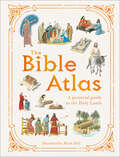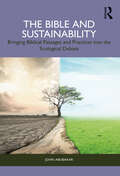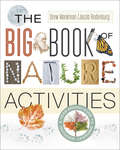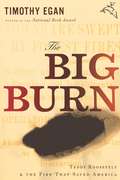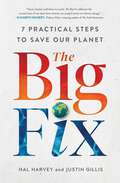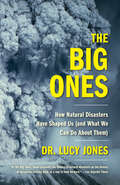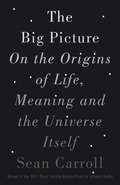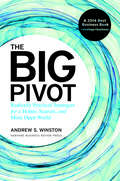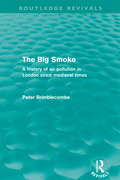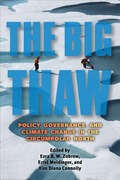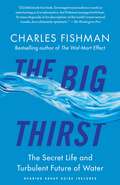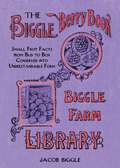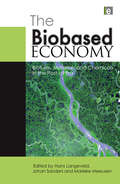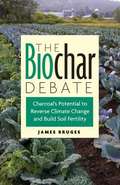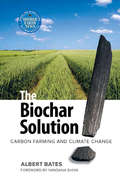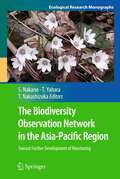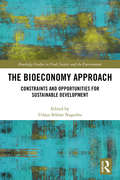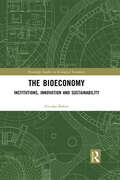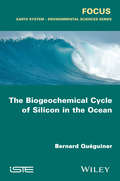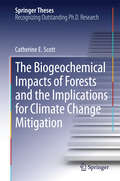- Table View
- List View
The Bible Atlas (DK Pictorial Atlases)
by DKDiscover where events in the Old and New Testaments took place and see how people lived in Biblical times in this illustrated guide.Take a trip around the Holy Land with this collection of beautifully drawn maps, which show where events from the Bible took place.Introducing The Bible Atlas – a beautifully illustrated guide to the geography, events and people of the Old and New Testaments for children aged 9-12. In illustrated guide, follow the journeys of the patriarchs, view inside Solomon's Temple, witness Jesus' miracles, and see exactly where Paul traveled while spreading the message of Christianity.Dive straight into this pictorial Bible guide for kids, offering: - An illustrated guide to key events of the Old and New Testaments for children.- A variety of maps showing in detail where events from the Bible took place.- An original and retro-feel illustration style combined with modern fonts, which creates a different approach compared to photographic or CGI-based books.As well as recapping many of the stories from both the Old and New Testaments, each page in this Bible guide provides additional information, illustrations, and photos explaining how people lived, who ruled the lands, and what places look like today. The information is presented in a visual and accessible way for children to grasp, immersing themselves in each map as they follow the stories and read summaries from the Bible.More in the seriesIf you like The Bible Atlas, then why not complete the collection? Take a peek inside the beautiful and absorbing world of birds with The Bird Atlas, explore the complex animal kingdom with The Animal Atlas, reveal the inner workings of the human body with The Body Atlas, take a trip around the globe with The Earth Atlas, and dive deep below the sea with The Oceans Atlas.
The Bible and Sustainability: Bringing Biblical Passages and Practices into the Ecological Debate
by John AbubakarThe Bible and Sustainability addresses the ecological crisis the world is facing, and what the Bible can teach us about sustainable living. Drawing on the interest in the ecological debate generated by Laudato Si, this book attempts to push the discussion beyond intellectual perspectives and help students and researchers apply biblical wisdom to the UN sustainable development goals.It begins with a discussion of what sustainability is, and how people, planet, and profit are affected by unsustainable practices, before exploring four specific biblical practices and their relationship with sustainability: Covenants, the sabbatical year, monastic communities, and the fruit of the spirit. It also discusses the creation account and personalistic nature texts, considering the social relationship that humans have with nature. Finally, it examines an Augustinian perspective on sustainability which encourages sharing, common ownership of property, and living simply. The book concludes by inviting governments, civil society organizations, and academia to bring these biblical practices and passages into the ecological debate.It is an outstanding resource for researchers of the Bible and environment, and Religion and environment more generally.
The Big Book of Nature Activities: A Year-Round Guide to Outdoor Learning
by Jacob Rodenburg Drew MonkmanThe average child can identify over one thousand corporate logos, but only ten native plants or animals--a telling indictment of our modern disconnection from nature. Soaring levels of obesity, high rates of ADHD, feelings of stress and social awkwardness, and "Nature Deficit Disorder" are further unintended consequences of a childhood spent primarily indoors.The Big Book of Nature Activities is a comprehensive guide for parents and educators to help youth of all ages explore, appreciate and connect with the natural world. This rich, fully illustrated compendium features: Nature-based skills and activities such as species identification, photography, journaling, and the judicious use of digital technology Ideas, games, and activities grounded in what's happening in nature each season Core concepts that promote environmental literacy, such as climate change and the mechanisms and wonder of evolution, explained using a child-friendly, engaging approach Lists of key species and happenings to observe throughout the year across most of North AmericaPerfect for families, educators, and youth leaders , The Big Book of Nature Activities is packed with crafts, stories, information and inspiration to make outdoor learning fun.Jacob Rodenburg is the Executive Director of the Camp Kawartha summer camp and outdoor education centre. As well as publishing numerous articles on children, nature and the environment, he has worked in the field of outdoor education for twenty-five years.Drew Monkman is an award-winning environmental advocate, naturalist, and retired teacher. In addition to his weekly nature column, Drew is the author of two season-based nature guides, including Nature's Year.
The Big Burn: Teddy Roosevelt and the Fire that Saved America (Playaway Adult Nonfiction Ser.)
by Timothy EganNational Book Award-winner Timothy Egan turns his historian's eye to the largest-ever forest fire in America and offers an epic, cautionary tale for our time. On the afternoon of August 20, 1910, a battering ram of wind moved through the drought-stricken national forests of Washington, Idaho, and Montana, whipping the hundreds of small blazes burning across the forest floor into a roaring inferno that jumped from treetop to ridge as it raged, destroying towns and timber in the blink of an eye. Forest rangers had assembled nearly ten thousand men to fight the fires, but no living person had seen anything like those flames, and neither the rangers nor anyone else knew how to subdue them. Egan recreates the struggles of the overmatched rangers against the implacable fire with unstoppable dramatic force, and the larger story of outsized president Teddy Roosevelt and his chief forester, Gifford Pinchot, that follows is equally resonant. Pioneering the notion of conservation, Roosevelt and Pinchot did nothing less than create the idea of public land as our national treasure, owned by every citizen. Even as TR's national forests were smoldering they were saved: The heroism shown by his rangers turned public opinion permanently in favor of the forests, though it changed the mission of the forest service in ways we can still witness today.
The Big Cloud
by Camille Seaman Alan BurdickOur culture is addicted to weather: hourly forecasts, apps, radio, TV channels, alerts, warnings, and watches. And understandably—our food, clothing, livelihoods, and, increasingly, safety are tied directly to the weather and climate change. In The Big Cloud, photographer Camille Seaman stands in front of tornados, at the edges of lightning storms, and in pelting hail under pitch-black skies to capture supercells and mammatus clouds in their often sublime and terrifying splendor. In these awe-inspiring photographs, Seaman's work is a potent reminder that there is no art more dramatic, in scale or emotion, than that created by nature. Big Cloud includes an introduction by award-winning New Yorker science writer and author Alan Burdick (Out of Eden, Why Time Flies).
The Big Fix: Seven Practical Steps to Save Our Planet
by Hal Harvey Justin GillisAn engaging, accessible citizen&’s guide to the seven urgent changes that will really make a difference for our climate—and how we can hold our governments accountable for putting these plans into action.Dozens of kids in Montgomery County, Maryland, agitated until their school board committed to electric school buses. Mothers in Colorado turned up in front of an obscure state panel to fight for clean air. If you think the only thing you can do to combat climate change is to install a smart thermostat or cook plant-based burgers, you&’re thinking too small. That&’s where The Big Fix comes in, offering everyday citizens a guide to the seven essential changes our communities must enact to bring our greenhouse gas emissions down to zero—and sharing stories of people who are making those changes reality. Energy policy advisor Hal Harvey and longtime New York Times reporter Justin Gillis hone in on the seven areas where ambitious but eminently practical changes will have the greatest effect: electricity production, transportation, buildings, industry, urbanization, use of land, and investment in promising new green technologies. In a lively, jargon-free style, the pair illuminate how our political economy really works, revealing who decides everything from what kind of power plants to build to how efficient cars must be before they&’re allowed on the road to how much insulation a new house requires—and how we can insert ourselves into all these decisions to ensure that the most climate-conscious choices are being made. At once pragmatic and inspiring, The Big Fix is an indispensable action plan for citizens looking to drive our country&’s greenhouse gas emissions down to zero—and save our climate.
The Big One: The Cascadia Earthquakes and the Science of Saving Lives (Scientists in the Field Series)
by Elizabeth RuschNo one ever thought the Pacific Northwest was due for an earthquake, let alone a catastrophic one. But geologists are transforming our understanding of the grave dangers the population in the region of Cascadia face—will there be a big one? And what can be done to save lives? America's Pacific Northwest has relatively few earthquakes—only a handful each year that cause even moderately noticeable shaking. But a couple decades ago, scientists discovered a geological feature running along the coast that in other parts of the world regularly triggers massive earthquakes of 8.0 magnitude and higher. Were there once massive earthquakes in this part of the world? Geologists think there were. Now a small group of scientists are studying things that you might not think have anything to do with earthquakes—marsh soil, ocean sediments, landslide debris, and ghost forests—and they have reason to believe that the Pacific Northwest is likely not as idyllic as it was once assumed. The population is likely in grave danger of a massive earthquake at some point. What can be done? The big one can't be stopped, but scientists are working tirelessly to learn as much as they can to prepare.
The Big Ones: How Natural Disasters Have Shaped Us (and What We Can Do About Them)
by Lucy JonesBy the world-renowned seismologist, a riveting history of natural disasters, their impact on our culture, and new ways of thinking about the ones to comeEarthquakes, floods, tsunamis, hurricanes, volcanoes--they stem from the same forces that give our planet life. Earthquakes give us natural springs; volcanoes produce fertile soil. It is only when these forces exceed our ability to withstand them that they become disasters. Together they have shaped our cities and their architecture; elevated leaders and toppled governments; influenced the way we think, feel, fight, unite, and pray. The history of natural disasters is a history of ourselves.In The Big Ones, leading seismologist Dr. Lucy Jones offers a bracing look at some of the world's greatest natural disasters, whose reverberations we continue to feel today. At Pompeii, Jones explores how a volcanic eruption in the first century AD challenged prevailing views of religion. She examines the California floods of 1862 and the limits of human memory. And she probes more recent events--such as the Indian Ocean tsunami of 2004 and the American hurricanes of 2017--to illustrate the potential for globalization to humanize and heal.With population in hazardous regions growing and temperatures around the world rising, the impacts of natural disasters are greater than ever before. The Big Ones is more than just a work of history or science; it is a call to action. Natural hazards are inevitable; human catastrophes are not. With this energizing and exhaustively researched book, Dr. Jones offers a look at our past, readying us to face down the Big Ones in our future.
The Big Picture: On the Origins of Life, Meaning, and the Universe Itself
by Sean CarrollOver the last few hundred years an avalanche of discoveries have changed our world dramatically, having a profound effect on what we think really matters. Now, theoretical physicist Sean Carroll breaks down how the universe works at the quantum, cosmic and human levels, and links them together to reveal how our human values relate to scientific reality.A synthesis of cosmos-sprawling science and the most profound questions about life, death and our place in the universe, The Big Picture is the ultimate guide through the scientific revolution that has taken us from Darwin and Einstein to the origins of life, consciousness and the universe. As Carroll's eloquent quest to explain everything demonstrates, our lives may forever be dwarfed by the immensity of the universe but they can be redeemed by our capacity to comprehend it and give it meaning.
The Big Pivot
by Andrew S. WinstonWe live in a fundamentally changed world. It's time for your approach to strategy to change, too.The evidence is all around us. Extreme weather, driven by climate change, is shattering records all over the planet. Our natural resources are in greater demand than ever before as a billion more people enter the global middle class, wanting more of everything. Radical transparency is opening up company operations and supply chains to public scrutiny.This is not some futuristic scenario or model to debate, but today's reality. We've passed an economic tipping point. A weakening of the foundations of our planetary infrastructure is costing businesses dearly and putting our society at risk. The mega challenges of climate change, scarcity, and radical transparency threaten our ability to run an expanding global economy and are profoundly changing "business as usual." But they also offer unprecedented opportunities: multi-trillion-dollar markets are in play, and the winners of this new game will profit mightily.According to Andrew Winston, bestselling author (Green to Gold) and globally recognized business strategist, the way companies currently operate will not allow them to keep up with the current-and future-rate of change. They need to make the Big Pivot.In this indispensable new book, Winston provides ten crucial strategies for leaders and companies ready to move boldly forward and win in this new reality. With concrete advice and tactics, and new stories from companies like British Telecom, Diageo, Dow, Ford, Nike, Unilever, Walmart, and many others, The Big Pivot will help you, and all of us, create more resilient businesses and a more prosperous world. This book is the blueprint to get you started.
The Big Pivot
by Andrew S. WinstonWe live in a fundamentally changed world. It's time for your approach to strategy to change, too.The evidence is all around us. Extreme weather, driven by climate change, is shattering records all over the planet. Our natural resources are in greater demand than ever before as a billion more people enter the global middle class, wanting more of everything. Radical transparency is opening up company operations and supply chains to public scrutiny.This is not some futuristic scenario or model to debate, but today's reality. We've passed an economic tipping point. A weakening of the foundations of our planetary infrastructure is costing businesses dearly and putting our society at risk. The mega challenges of climate change, scarcity, and radical transparency threaten our ability to run an expanding global economy and are profoundly changing "business as usual." But they also offer unprecedented opportunities: multi-trillion-dollar markets are in play, and the winners of this new game will profit mightily.According to Andrew Winston, bestselling author (Green to Gold) and globally recognized business strategist, the way companies currently operate will not allow them to keep up with the current-and future-rate of change. They need to make the Big Pivot.In this indispensable new book, Winston provides ten crucial strategies for leaders and companies ready to move boldly forward and win in this new reality. With concrete advice and tactics, and new stories from companies like British Telecom, Diageo, Dow, Ford, Nike, Unilever, Walmart, and many others, The Big Pivot will help you, and all of us, create more resilient businesses and a more prosperous world. This book is the blueprint to get you started.
The Big Pivot
by Andrew S. WinstonWe live in a fundamentally changed world. It's time for your approach to strategy to change, too.The evidence is all around us. Extreme weather, driven by climate change, is shattering records all over the planet. Our natural resources are in greater demand than ever before as a billion more people enter the global middle class, wanting more of everything. Radical transparency is opening up company operations and supply chains to public scrutiny.This is not some futuristic scenario or model to debate, but today's reality. We've passed an economic tipping point. A weakening of the foundations of our planetary infrastructure is costing businesses dearly and putting our society at risk. The mega challenges of climate change, scarcity, and radical transparency threaten our ability to run an expanding global economy and are profoundly changing "business as usual." But they also offer unprecedented opportunities: multi-trillion-dollar markets are in play, and the winners of this new game will profit mightily.According to Andrew Winston, bestselling author (Green to Gold) and globally recognized business strategist, the way companies currently operate will not allow them to keep up with the current-and future-rate of change. They need to make the Big Pivot.In this indispensable new book, Winston provides ten crucial strategies for leaders and companies ready to move boldly forward and win in this new reality. With concrete advice and tactics, and new stories from companies like British Telecom, Diageo, Dow, Ford, Nike, Unilever, Walmart, and many others, The Big Pivot will help you, and all of us, create more resilient businesses and a more prosperous world. This book is the blueprint to get you started.
The Big Rock
by Bruce HiscockTraces the origins of a granite rock located near the Adirondack Mountains and describes how it reveals information about the history of the earth.
The Big Smoke: A History of Air Pollution in London since Medieval Times (Routledge Revivals)
by Peter BrimblecombeFirst published in 1987, Peter Brimblecombe's book provides an engaging historical account of air pollution in London, offering a fascinating insight into the development of air pollution controls against a changing social and economic background. He examines domestic and industrial pollution and their effects on fashions, furnishings, buildings and human health. The book ends with an intriguing analysis of the dangers arising from contemporary pollutants and a glimpse of what the future may hold for London.
The Big Thaw: Policy, Governance, and Climate Change in the Circumpolar North (SUNY series in Environmental Governance: Local-Regional-Global Interactions)
by Ezra B. W. Zubrow; Errol Meidinger; Kim Diana ConnollyClimate change, one of the drivers of global change, is controversial in political circles, but recognized in scientific ones as being of central importance today for the United States and the world. In The Big Thaw, the editors bring together experts, advocates, and academic professionals who address the serious issue of how climate change in the Circumpolar Arctic is affecting and will continue to affect environments, cultures, societies, and economies throughout the world. The contributors discuss a variety of topics, including anthropology, sociology, human geography, community economics, regional development and planning, and political science, as well as biogeophysical sciences such as ecology, human-environmental interactions, and climatology.This book is freely available in an open access edition thanks to Knowledge Unlatched—an initiative that provides libraries and institutions with a centralized platform to support OA collections and from leading publishing houses and OA initiatives. Learn more at the Knowledge Unlatched website at: https://www.knowledgeunlatched.org/, and access the book online at the SUNY Open Access Repository at http://hdl.handle.net/20.500.12648/7130.
The Big Thirst: The Secret Life and Turbulent Future of Water
by Charles FishmanPraised as &“an entertaining and torrential flow of a book&” by Nature magazine, The Big Thirst is a startling examination of the passing of the golden age of water and the shocking facts about how water scarcity will soon be a major factor in our lives.The water coming out of your kitchen tap is four billion years old and might well have been sipped by a Tyrannosaurus rex. Rather than only three states of water—liquid, ice, and vapor—there is a fourth, &“molecular water,&” fused into rock 400 miles deep in the Earth, and that&’s where most of the planet&’s water is found. Unlike most precious resources, water cannot be used up; it can always be made clean enough again to drink—indeed, water can be made so clean that it&’s toxic. Water is the most vital substance in our lives but also more amazing and mysterious than we appreciate. As Charles Fishman brings vibrantly to life in this surprising and mind-changing narrative, water runs our world in a host of awe-inspiring ways, yet we take it completely for granted. But the era of easy water is over. Bringing readers on a lively and fascinating journey—from the wet moons of Saturn to the water-obsessed hotels of Las Vegas, where dolphins swim in the desert, and from a rice farm in the parched Australian outback to a high-tech IBM plant that makes an exotic breed of pure water found nowhere in nature—Fishman vividly shows that we&’ve already left behind a century-long golden age when water was thoughtlessly abundant, free, and safe and entered a new era of high-stakes water. In 2008, Atlanta came within ninety days of running entirely out of clean water. California is in a desperate battle to hold off a water catastrophe. And in the last five years Australia nearly ran out of water—and had to scramble to reinvent the country&’s entire water system. But as dramatic as the challenges are, the deeper truth Fishman reveals is that there is no good reason for us to be overtaken by a global water crisis. We have more than enough water. We just don&’t think about it, or use it, smartly. The Big Thirst brilliantly explores our strange and complex relationship to water. We delight in watching waves roll in from the ocean; we take great comfort from sliding into a hot bath; and we will pay a thousand times the price of tap water to drink our preferred brand of the bottled version. We love water—but at the moment, we don&’t appreciate it or respect it. Just as we&’ve begun to reimagine our relationship to food, a change that is driving the growth of the organic and local food movements, we must also rethink how we approach and use water. The good news is that we can. As Fishman shows, a host of advances are under way, from the simplicity of harvesting rainwater to the brilliant innovations devised by companies such as IBM, GE, and Royal Caribbean that are making impressive breakthroughs in water productivity. Knowing what to do is not the problem. Ultimately, the hardest part is changing our water consciousness. As Charles Fishman writes, &“Many civilizations have been crippled or destroyed by an inability to understand water or manage it. We have a huge advantage over the generations of people who have come before us, because we can understand water and we can use it smartly.&” The Big Thirst will forever change the way we think about water, about our essential relationship to it, and about the creativity we can bring to ensuring that we&’ll always have plenty of it.
The Biggle Berry Book: Small Fruit Facts from Bud to Box Conserved into Understandable Form
by Jacob Biggle"The only just and true way for an honorable and manly man is to grow them, and let everybody about the place have all he can eat. For the berry comes from the garden to the table in tempting and presentable shape, fit to grace the table of a king," writes Jacob Biggle in The Biggle Berry Book, which was first published in 1894. If you hate plunking down what seems like a king's ransom every time you buy a quart of berries at the local farmer's market, and if you've got a little land to spare, it might be time to grow your own.Jacob Biggle shows just how easy it is to raise your own nutrient-rich berries. While the book's emphasis is on more common fruit such as strawberries, raspberries, blackberries, currants, gooseberries, and grapes, there is also information from other berry growers living in all parts of America who raised less familiar varieties such as dewberries, juneberries, loganberries, mulberries, and mayberries. Biggle's trusty manual contains advice on, among other things:How to keep your berry patch pruned, cleaned, cultivated, and in good orderHow to protect your plants from fungus and insect damageThe best ways to pick, pack, and market your berries, if you're willing to part with them,Enhanced with color plates, beautiful engravings, and vintage photographs, The Biggle Berry Book is a treasure for anyone who appreciates the taste and freshness of homegrown fruit.
The Biobased Economy: Biofuels, Materials and Chemicals in the Post-oil Era
by Johan Sanders Marieke Meeusen Hans LangeveldThe impending threats of catastrophic climate change and peak oil are driving our society towards increased use of biomass for energy, chemical compounds and other materials - the beginnings of a biobased economy. As alternative development models for the biobased economy emerge, we need to determine potential applications, their perspectives and possible impacts as well as policies that can steer technological and market development in such a way that our objectives are met. Currently, it is still far from clear what will be the most sustainable routes to follow, which technologies should be included, and how their development will affect, and be affected by, research, public opinion and policy and market forces. This groundbreaking work, edited by a group of leading researchers originally from Wageningen Agricultural University in the Netherlands, sets out to unpick the complex systems in play. It provides an illuminating framework for how policy and market players could and should drive the development of a biobased economy that is effective, sustainable, fair and cost efficient. Starting with a state-of-the-art overview of major biobased technologies, including biorefinery and technologies for the production of biofuels, biogas, biomass feedstocks for chemistry and bioplastics, it discusses how different actor groups interact through policy and markets. Information from case studies is used to demonstrate how the potential of the biobased economy in different parts of the world, such as North America, Europe, and emerging economies like China and Brazil can be realised using research, debate, policy and commercial development. The result is an essential resource for all those working in or concerned with biobased industries, their policy or research.
The Biochar Debate
by James BrugesThe Biochar Debateis the first book to introduce both the promise and concerns surrounding biochar (fine-grained charcoal used as a soil supplement) to nonspecialists. Charcoal making is an ancient technology. Recent discoveries suggest it may have a surprising role to play in combating global warming. This is because creating and burying biochar removes carbon dioxide from the atmosphere. Furthermore, adding biochar to soil can increase the yield of food crops and the ability of soil to retain moisture, reducing need for synthetic fertilizers and demands on scarce fresh-water supplies. While explaining the excitement of biochar proponents, Bruges also gives voice to critics who argue that opening biochar production and use to global carbon-credit trading schemes could have disastrous outcomes, especially for the world's poorest people. The solution, Bruges explains, is to promote biochar through an alternative approach called the Carbon Maintenance Fee that avoids the dangers. This would establish positive incentives for businesses, farmers, and individuals to responsibly adopt biochar without threatening poor communities with displacement by foreign investors seeking to profit through seizure of cheap land. The Biochar Debatecovers the essential issues from experimental and scientific aspects of biochar in the context of global warming to fairness and efficiency in the global economy to negotiations for the future of the Kyoto Protocol.
The Biochar Solution
by Albert BatesConventional agriculture destroys our soils, pollutes our water, and is a major contributor to climate change. What if our agricultural practices could stabilize, or even reverse these trends?The Biochar Solution explores the dual function of biochar as a carbon-negative energy source and a potent soil-builder. Created by burning biomass in the absence of oxygen, this material has the unique ability to hold carbon back from the atmosphere while simultaneously enhancing soil fertility. Albert Bates traces the evolution of this extraordinary substance, from the ancient black soils of the Amazon to its reappearance as a modern carbon sequestration strategy.Combining practical techniques for the production and use of biochar with an overview of the development and future of carbon farming, The Biochar Solution describes how a new agricultural revolution can reduce net greenhouse gas emissions to below zero while increasing world food reserves and creating energy from biomass wastes. Biochar and carbon farming can:*Reduce fossil fuels inputs into our food system*Bring new life to desert landscapes*Filter and purify drinking water*Help build carbon-negative homes, communities, and nationsBiochar is not without dangers if unregulated, and it is not a panacea, but if it fulfills its promise of taking us back from the brink of irreversible climate change, it may well be the most important discovery in human history.
The Biodiversity Observation Network in the Asia-Pacific Region
by Shin-Ichi Nakano Tetsukazu Yahara Tohru NakashizukaBiological diversity is important for ecosystem function and services, which in turn is essential for human well-being. Under the Convention on Biological Diversity, international efforts have been made to achieve a significant reduction in the current rate of biodiversity loss. The loss continues, however. The Asia-Pacific region includes both developing countries with high biodiversity and developed countries with sophisticated data collection and analyses, but only limited information about the status quo of biodiversity in this region has been available. Many Asia-Pacific countries have rapidly grown their economies and social infrastructures, causing a loss of biodiversity and requiring an urgent mandate to achieve a balance between development and conservation in the region. In December 2009, scientists successfully organized the Asia-Pacific Biodiversity Observation Network in the region, to establish a network for research and monitoring of ecosystems and biodiversity and to build a cooperative framework. The present volume is the first collection of information on biodiversity in the Asia-Pacific and represents a quantum step forward in science that optimizes the synergy between development and biodiversity conservation.
The Bioeconomy Approach: Constraints and Opportunities for Sustainable Development (Routledge Studies in Food, Society and the Environment)
by Udaya Sekhar NagothuThis book examines the bioeconomy concept, analysing the opportunities it can generate, the constraints and the potential benefits for society. The main objective of bioeconomy is to promote economic development, by creating jobs and enhancing the sustainable utilization of bio-resources. A primary driver of bioeconomy strategy, therefore, is the need to respond to the growing population's food and economic requirements. While today research and literature related to bioeconomy are limited, this book presents a unique collection of perspectives on the complex dimensions of the bioeconomy debate. Drawing on the experiences from Europe, Asia and Africa, it presents an international overview. The chapters address a wide range of issues, including coastal-land interactions, ecosystem services, food production, rural development, agriculture, forest management and bioenergy. As a whole, the volume outlines what role bioeconomy can play in contributing to the United Nations Sustainable Development Goals (SDGs) without compromising on the ecological sustainability and equitable distribution of benefits. The book concludes by providing recommendations for developing bioeconomy in respective sectors (agriculture, forestry, fisheries, renewable energy) and directions for planning future bioeconomy programmes and strategies. The Bioeconomy Approach will be of great interest to students and scholars of ecological economics, development economics and environmental economics, as well as policy-makers and practitioners involved in sustainable development.
The Bioeconomy: Institutions, Innovation and Sustainability (Routledge Studies in Ecological Economics)
by Nicolas BefortThe bioeconomy is steadily becoming more important in regional, national and European public policies. As it encompasses the transformation of agricultural, marine and organic resources into food, feed, fuels, energy and materials, the bioeconomy should become a major new industry, outlining the possibility of a post-fossil future. This book is the first attempt to depict the origins, formation and challenges of this new industry in terms of emerging institutions, innovation, and economic strategies. The result of this work is that the substitution of raw materials alone is not enough to get out of the fossil economy. This book develops a political economy of the ecological transition which theorizes the transition as a new crisis of capitalism. This phase is characterized by stakeholders’ attempts to develop renewed rationales and strategies to take control of the reorganization of flows of natural resources, their outcomes and their evaluation. The proposed framework considers recent results in four complementary research strands: transition studies, institutional economics, ecological economics, and the evolutionary economics of innovation. The book will be of interest to researchers interested in the development of the bioeconomy, and both researchers and students seeking to understand the role of heterodox economics in the ecological transition.
The Biogeochemical Cycle of Silicon in the Ocean
by Bernard QuéguinerThe biogeochemical cycle of silicon in the ocean: Chemical forms, techniques of analysis, the silicifiers, processes of biogenic silica production and control mechanisms, mechanisms of dissolution, silicon in the major oceanic regions, global cycle and relationship with the biological carbon pump. This book proposes to establish the state-of-the-art on the biogeochemical cycle of silicon in the modern marine environment. It aims to provide a basic outline of: the chemistry of particulate and dissolved silicon, including the standard methods of analysis, the description and the role of living organisms and physico-chemical processes involved in the mechanisms of transformation of siliceous material, the key position of this element in the biogeochemical dynamics of major ocean regions, and finally its global biogeochemical cycle.
The Biogeochemical Impacts of Forests and the Implications for Climate Change Mitigation
by Catherine E. ScottForests and vegetation emit biogenic volatile organic compounds (BVOCs) into the atmosphere which, once oxidized, can partition into the particle phase, forming secondary organic aerosols (SOAs). This thesis reports on a unique and comprehensive analysis of the impact of BVOC emissions on atmospheric aerosols and climate. A state-of-the-art global aerosol microphysics model is used to make the first detailed assessment of the impact of BVOC emissions on aerosol microphysical properties, improving our understanding of the role of these emissions in affecting the Earth's climate The thesis also reports on the implications for the climate impact of forests. Accounting for the climate impacts of SOAs, taken together with the carbon cycle and surface albedo effects that have been studied in previous work, increases the total warming effect of global deforestation by roughly 20%.
